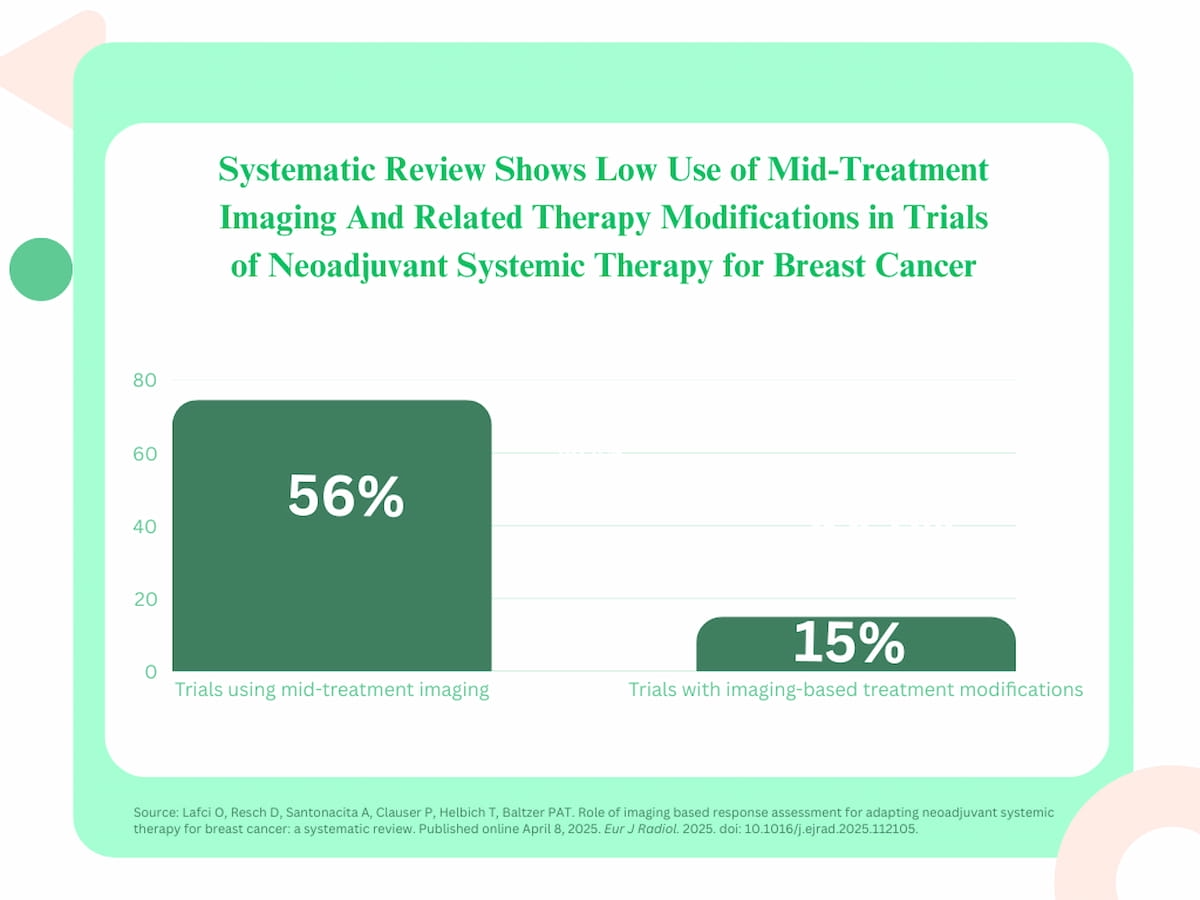How often are imaging modalities, such as mammography, breast magnetic resonance imaging (MRI) or ultrasound, utilized in clinical trial investigations to assess neoadjuvant systemic therapy (NST) for breast cancer?
In a new systematic review, recently published in the European Journal of Radiology, researchers reviewed five clinical practice guidelines as well as data from 147 clinical trials of NST for breast cancer to gauge the use of imaging to make treatment modifications for those with early or locally advanced breast cancer.
Mid-treatment imaging was utilized in 83 of the 147 NST trials (56 percent) and only 22 of those studies (15 percent) involved treatment modifications based on imaging results, according to the review authors.
“ … The scarcity of trials exploring imaging response-guided treatment indicates that, in most clinical studies, imaging was mainly used for documentation purposes rather than for guiding clinical decisions,” wrote lead review author Oguz Lafci, M.D., who is affiliated with the Division of General and Pediatric Radiology and the Department of Biomedical Imaging and Image-Guided Therapy at the Medical University of Vienna in Vienna, Austria, and colleagues.
The review authors noted that ultrasound was utilized in 61 percent of the trials (90/147), MRI was employed in 50 percent of studies (74/147) and mammography was referenced in 39 percent of the trials (57/147).
However, in the 22 NST trials that incorporated imaging response-guided treatment, the researchers pointed out significant variety with the utilized modalities and the timing for clinical decision-making. The review authors noted that ultrasound was the sole imaging modality in seven studies, MRI was utilized as the sole imaging modality in three trials and a combination of ultrasound, MRI and mammography were used in three trials.
Imaging-guided treatment decisions were made after the fourth treatment cycle in seven studies, after the third treatment cycle in two studies, after the second treatment cycle in two studies, and after the fourth month of treatment in two studies. Treatment decisions based on imaging were also made at week four, week six and after every third treatment cycle in other studies, according to review authors.
“ … There was considerable variability in the timing of mid-treatment response evaluations across the studies, ranging from monitoring after each cycle to assessments conducted 2–3 months into treatment. This variability may be attributed to the distinct mechanisms of action of specific treatments, the varying time frames expected for their efficacy, and potential differences in treatment schedules even for the same drugs, which can influence the timeline of drug delivery and expected outcomes,” pointed out Lafci and colleagues.
Three Key Takeaways
1. Limited use of imaging to guide treatment. The review authors noted that mid-treatment imaging was only obtained in 56 percent (83/147) of neoadjuvant systemic therapy (NST) trials for breast cancer, and only 15 percent (22/147) of those studies utilized imaging results to modify treatment. This suggests that imaging is primarily used for documentation rather than clinical decision-making in clinical trials of NST for people with breast cancer.
2. Variability in imaging modalities and timing. Ultrasound was the most frequently used imaging modality (61 percent), followed by MRI (50 percent) and mammography (39 percent). Among the few studies that used imaging to guide treatment, there was significant variability in both the imaging methods and the timing of response assessments, ranging from every treatment cycle to several months into therapy.
3. Lack of standardized guidelines. There is currently a low level of evidence supporting imaging-guided response assessment for NST in existing clinical practice guidelines, and no consensus on timing. This has led to institutional variation and highlights the need for standardized, evidence-based imaging protocols in this setting.
However, the review authors noted a low evidence level for imaging response monitoring for NST in four clinical practice guidelines and a lack of consensus overall in guideline recommendations. The researchers also pointed out the absence of specific timing recommendations for imaging monitoring with NST in guidelines including those from the American Society of Clinical Oncology (ASCO), the National Comprehensive Cancer Network (NCCN) and the European Society for Medical Oncology (ESMO).
“ … In the absence of strong regulatory or guideline-driven recommendations, institutions may rely on local expertise or logistical convenience. This underscores the importance of developing standardized, evidence-based imaging protocols for NST response assessment,” emphasized Lafci and colleagues.
(Editor’s note: For related content, see “Breast MRI and Ultrasound Findings Linked to Elevated Risk of Axillary Residual Disease After Neoadjuvant Therapy,” “Surveillance Breast MRI Associated with Lower Risks of Advanced Second Breast Cancers” and “Can Diffusion MRI Predict Patient Response to Neoadjuvant Chemotherapy for Breast Cancer?”)
In regard to study limitations, the authors acknowledged a potential selection bias with their snowballing approach to targeting trials that helped shape guideline development. They also conceded a lack of analysis in evaluating the impact of different imaging modalities on outcomes in studies that involved treatment changes.
